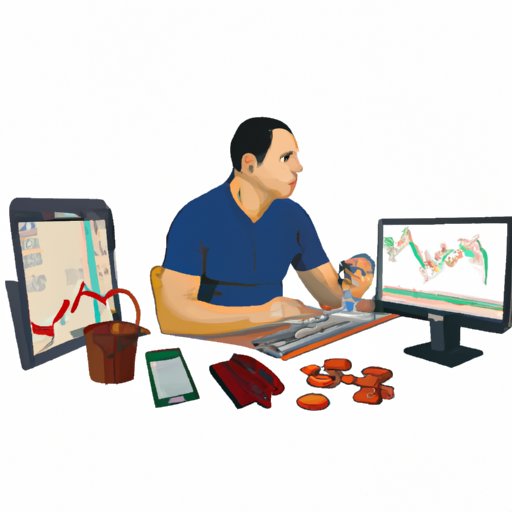Introduction
Trading is the exchange of goods or services between two parties. In financial markets, trading involves buying and selling assets such as stocks, bonds, and currencies. With online trading, individuals can access these markets from their computers and mobile devices and make trades in real-time. This article will provide an overview of how to start trading and the steps involved.
Definition of Trading
Trading is the process of exchanging one asset for another in order to make a profit. Trading involves buying and selling securities, commodities, and currencies in the hopes of making a profit from the price difference between the purchase and sale. It is important to understand the different types of trading available, such as day trading, swing trading, and position trading, before getting started.
Overview of Different Types of Trading
Day trading is the practice of buying and selling assets within the same trading day. Day traders look for opportunities to capitalize on short-term price movements and aim to close out their positions before the end of the day. Swing trading is a longer-term approach to trading that involves taking advantage of larger price movements over multiple days or weeks. Position trading is a long-term investment strategy that involves holding onto a position for a longer period of time in order to benefit from larger price trends.

Research and Select a Broker
The first step in starting to trade is to find a broker. A broker is a licensed professional who facilitates trades on behalf of clients. When selecting a broker, it is important to consider the products you want to trade and compare different brokerage services. Some brokers specialize in certain markets or asset classes, so it is important to find one that offers the products you are looking to trade.
Compare Brokerage Services
Once you have identified potential brokers, it is important to compare their services. Look for brokers that offer competitive fees, low minimum deposit requirements, and a variety of trading tools. It is also important to research customer reviews to get an understanding of the quality of service provided by the broker.
Choose a Broker
When selecting a broker, it is important to choose one that is regulated and has a good reputation. Make sure to read the fine print and understand any fees or other costs associated with the broker. Be sure to ask questions and get a clear understanding of the broker’s services before committing.
Open a Trading Account
Once you have selected a broker, the next step is to open a trading account. This typically involves submitting some basic information and providing proof of identity. Most brokers require customers to provide documents such as a government-issued photo ID, proof of address, and bank statements.
Fund Your Account
Once your account is approved, you will need to fund it before you can start trading. Most brokers accept deposits via credit or debit cards, wire transfers, and e-wallets. The minimum deposit required will vary by broker, so it is important to check this before opening an account.

Learn the Basics of Trading
Before you start trading, it is important to learn the basics. This includes understanding market analysis, risk management, and the different types of orders you can use when placing trades. There are many resources available to help new traders learn the fundamentals, including books, online courses, and webinars.
Develop a Trading Strategy
Having a trading strategy is essential for success. Before entering a trade, it is important to set goals, determine your risk tolerance, and create a strategy that fits your needs. A trading strategy should include entry and exit points, risk management rules, and position sizing guidelines.

Set Up Your Trading Platform
Once you have developed a trading strategy, it is important to find the right trading platform. There are many software programs available that allow traders to analyze data, place trades, and manage their portfolios. It is important to familiarize yourself with the features of the platform you choose in order to maximize its effectiveness.
Practice Trading
Before investing real money, it is important to practice trading. Most brokers offer a demo account that allows traders to test out their strategies without risking real capital. This is a great way to get comfortable with the platform and avoid common mistakes.
Conclusion
Trading can be a rewarding activity, but it is important to take the necessary steps to ensure success. This includes researching and selecting a broker, opening a trading account, learning the basics, developing a strategy, setting up a trading platform, and practicing trading. By following these steps, you can get started trading safely and confidently.
(Note: Is this article not meeting your expectations? Do you have knowledge or insights to share? Unlock new opportunities and expand your reach by joining our authors team. Click Registration to join us and share your expertise with our readers.)
